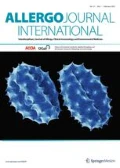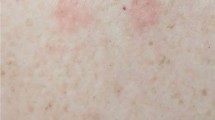Abstract
Drug hypersensitivity reactions are unpredictable adverse drug reactions. They manifest either within 1–6 h following drug intake (immediate reactions) with mild to life-threatening symptoms of anaphylaxis, or several hours to days later (delayed reactions), primarily as exanthematous eruptions. It is not always possible to detect involvement of the immune system (allergy). Waiving diagnostic tests can result in severe reactions on renewed exposure on the one hand, and to unjustified treatment restrictions on the other. With this guideline, experts from various specialist societies and institutions have formulated recommendations and an algorithm for the diagnosis of allergies. The key principles of diagnosing allergic/hypersensitivity drug reactions are presented. Where possible, the objective is to perform allergy diagnostics within 4 weeks–6 months following the reaction. A clinical classification of symptoms based on the morphology and time course of the reaction is required in order to plan a diagnostic work-up. In the case of typical symptoms of a drug hypersensitivity reaction and unequivocal findings from validated skin and/or laboratory tests, a reaction can be attributed to a trigger with sufficient confidence. However, skin and laboratory tests are often negative or insufficiently reliable. In such cases, controlled provocation testing is required to clarify drug reactions. This method is reliable and safe when attention is paid to indications and contraindications and performed under appropriate medical supervision. The results of the overall assessment are discussed with the patient and documented in an „allergy passport“ in order to ensure targeted avoidance in the future and allow the use of alternative drugs where possible.
Similar content being viewed by others
Abbreviations
- ACTH:
-
Adrenocorticotropic hormone
- AGEP:
-
Acute generalized exanthematous pustulosis
- CAST:
-
Cellular antigen stimulation test
- DRESS:
-
Drug reaction with eosinophilia and systemic symptoms
- EBV:
-
Epstein-Barr virus
- ELISpot:
-
Enzyme-Linked ImmunoSpot
- ENDA:
-
European Network on Drug Allergy
- HIV:
-
Human immunodeficiency virus
- HLA:
-
Human leukocyte antigen
- Ig:
-
Immunoglobulin
- NA:
-
Not applicable or no concentration recommended
- NSAID:
-
Non-steroidal anti-inflammatory drug
- sIgE:
-
Specific immunoglobulin E
- SJS:
-
Stevens-Johnson syndrome
- TEN:
-
Toxic epidermal necrolysis
- ADR:
-
Adverse drug reactions
- UV:
-
Ultraviolet radiation
References
Demoly P, Adkinson NF, Brockow K et al. International Consensus (ICON) on Drug Allergy. Allergy 2014;69:420–437
Przybilla B, Aberer W, Bircher AJ et al. Allergologische Diagnostik von Überempfindlichkeitsreaktionen auf Arzneimittel. Allergo J 2008;17:90–94
Bircher AJ, Scherer Hofmeier K. Drug hypersensitivity reactions: inconsistency in the use of the classification of immediate and nonimmediate reactions. J Allergy Clin Immunol 2012;129:263–264; author reply 265-6
Gomes E, Pichler W, Demoly P et al. The drug ambassador project: the diversity of diagnostic procedures for drug allergy around Europe. J World Allergy Org 2004;17:1–10
Fernandez TD, Torres MJ, Blanca-Lopez N et al. Negativization rates of IgE radioimmunoassay and basophil activation test in immediate reactions to penicillins. Allergy 2009;64:242–248
Brockow K, Ring J. Anaphylaxis to radiographic contrast media. Curr Opin Allergy Clin Immunol 2011;11:326–331
Kim SH, Jo EJ, Kim MY et al. Clinical value of radiocontrast media skin tests as a prescreening and diagnostic tool in hypersensitivity reactions. Ann Allergy Asthma Immunol 2013;110:258–262 Wedi B. Fragebogen Medikamentenüberempfindlichkeit. Allergo J 2005;14:611-7 Demoly P, Kropf R, Bircher A, Pichler WJ. Drug hypersensitivity: questionnaire. EAACI interest group on drug hypersensitivity. Allergy 1999;54:999-1003
Rueff F, Bergmann KC, Brockow K et al. Hauttests zur Diagnostik von allergischen Soforttypreaktionen. Allergo J 2010;19:402–415
Brockow K, Romano A, Blanca M et al. General considerations for skin test procedures in the diagnosis of drug hypersensitivity. Allergy 2002;57:45–51
Mertes PM, Alla F, Trechot P et al. Anaphylaxis during anesthesia in France: an 8-year national survey. J Allergy Clin Immunol 2011;128:366–373
Brockow K. Dilemmas of allergy diagnosis in perioperative anaphylaxis. Allergy 2014;69:1265–1266
Brockow K, Garvey LH, Aberer W et al. Skin test concentrations for systemically administered drugs — an ENDA/EAACI Drug Allergy Interest Group position paper. Allergy 2013;68:702–712
Riezzo I, Bello S, Neri M et al. Ceftriaxone intradermal test-related fatal anaphylactic shock: a medico-legal nightmare. Allergy 2010;65:130–131
Ring J, Beyer K, Biedermann T et al. Akuttherapie und Management der Anaphylaxie. Allergo J Int 2014; 23:36–52
Muraro A, Roberts G, Worm M et al. Anaphylaxis: guidelines from the European Academy of Allergy and Clinical Immunology. Allergy 2014;69:1026–1045
Renz H, Becker WM, Bufe A et al. In-vitro-Allergiediagnostik. Positionspapier der Deutschen Gesellschaft für Allergologie und klinische Immunologie. Allergo J 2002;11:492–506
Brockow K. Arzneimittelreaktionen vom Soforttyp. Epidemiologie, Klinik, Auslöser und Management. Hautarzt 2014; 65:409–414
Ebo DG, Bridts CH, Mertens CH et al. Analyzing histamine release by flow cytometry (HistaFlow): a novel instrument to study the degranulation patterns of basophils. J Immunol Methods 2012;375:30–38
Porebski G, Gschwend-Zawodniak A, Pichler WJ. In vitro diagnosis of T cell-mediated drug allergy. Clin Exp Allergy 2011;41:461–470
Aberer W, Bircher A, Romano A et al. Drug provocation testing in the diagnosis of drug hypersensitivity reactions: general considerations. Allergy 2003;58:854–863
Kowalski ML, Asero R, Bavbek S et al. Classification and practical approach to the diagnosis and management of hypersensitivity to nonsteroidal anti-inflammatory drugs. Allergy 2013;68:1219–1232
Defrance C, Bousquet PJ, Demoly P. Evaluating the negative predictive value of provocation tests with nonsteroidal anti-inflammatory drugs. Allergy 2011;66:1410–1414
Demoly P, Romano A, Botelho C et al. Determining the negative predictive value of provocation tests with beta-lactams. Allergy 2010;65:327–332
Coombs PR, Gell PG. Classification of allergic reactions responsible for clinical hypersensitivity and disease. In: Clinical Aspects of Immunology, ed. Gell RR. Oxford: Oxford University Press, 1968; 575–596
Author information
Authors and Affiliations
Corresponding author
Additional information
Conflict of interests
The information on potential conflicts of interest have been reviewed by a steering-group which did not find any conflicts of interest which may affect the authors’ independency in the process of the development of this guideline. The authors’ disclosures are available in a table (together with the working-report on this guideline) on the AWMF-page of the S2k-Guideline for the diagnosis of drug hypersensitivity reactions via www.awmf.org/leitlinien/detail/ll/061-021.html.
Cite this as
Brockow K, Przybilla B, Aberer W, Bircher AJ, Brehler R, Dickel H, Fuchs T, Jakob T, Lange L, Pfützner W, Mockenhaupt M, Ott H, Pfaar O, Ring J, Sachs B, Sitter H, Trautmann A, Treudler R, Wedi B, Worm M, Wurpts G, Zuberbier T, Merk HF. Guideline for the diagnosis of drug hypersensitivity reactions. S2K-Guideline of the German Society for Allergology and Clinical Immunology (DGAKI) and the German Dermatological Society (DDG) in collaboration with the Association of German Allergologists (AeDA), the German Society for Pediatric Allergology and Environmental Medicine (GPA), the German Contact Dermatitis Research Group, the Swiss Society for Allergy and Immunology (SGAI), the Austrian Society for Allergology and Immunology (ÖGAI), the German Academy of Allergology and Environmental Medicine (DAAU), the German Center for Documentation of Severe Skin Reactions and the German Federal Institute for Drugs and Medical Products (BfArM). Allergo J Int 2015;24:94–105 DOI: 10.1007/s40629-015-0052-6
A correction to this article is available at http://dx.doi.org/10.1007/s15007-018-1526-x
Rights and permissions
About this article
Cite this article
Brockow, K., Przybilla, B., Aberer, W. et al. Guideline for the diagnosis of drug hypersensitivity reactions. Allergo J Int 24, 94–105 (2015). https://doi.org/10.1007/s40629-015-0052-6
Published:
Issue Date:
DOI: https://doi.org/10.1007/s40629-015-0052-6




